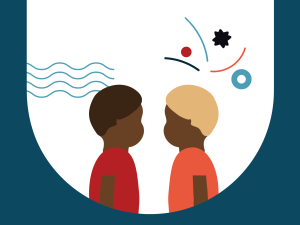Stay in the know
All our latest podcasts delivered right to your inbox.
Tantrums and meltdowns are challenges all parents face. But for families of kids who learn and think differently, they can be even more of a struggle.
In this episode, hosts Gretchen Vierstra and Rachel Bozek welcome back Dr. Andrew Kahn, the host of the first season of Understood’s What Now? A Parent’s Guide to Tantrums and Meltdowns. Tune in to get his expert advice on dealing with tantrums and meltdowns. Learn how practicing strategies ahead of time can help you manage outbursts in the moment. And find out what calming techniques can help.
Related resources
Check out Understood’s guide to tantrums and meltdowns
Plus, you can find more about managing tantrums and meltdowns in our free community app, Wunder. Check it out to get expert support and connect with other parents.
Episode transcript
Gretchen: From the Understood Podcast Network, this is "In It," a podcast about the ins and outs...
Rachel: ...the ups and downs,
Gretchen: ...of supporting kids who learn and think differently. I'm Gretchen Vierstra, a former classroom teacher and an editor here at Understood.
Rachel: And I'm Rachel Bozek, a writer and editor with a family that's definitely in it. Recently, we dropped an episode of the new Understood podcast, "What Now,?" in our feed.
Gretchen: The podcast is hosted by one of our more frequent guests, Andy Kahn. And in this first season, he's offering lots of concrete advice on how to navigate our kids' tantrums and meltdowns.
Rachel: It's super helpful. And each of the eight episodes is less than ten minutes long, which makes it easy to access, even if you don't have a lot of downtime.
Gretchen: We know that tantrums and meltdowns are a big part of being "in it." So, we've invited Andy to join us on this podcast, for a longer conversation, so we can dive a bit deeper into some of the strategies he shares.
Rachel: So, Andy, welcome back to "In It." As we've mentioned, you are the host of the first season of the podcast "What Now,?" which is all about how to help your child and help yourself with tantrums and meltdowns. So, I guess the first question is, why did this feel like an important topic to cover?
Andy: Yeah, that's a great question. So, the whole idea around "What Now?" was trying to think about how to deliver to listeners and to watchers, information that they might have gotten out of a therapy session or out of an interaction in treatment that many people aren't accessing.
So, when we talked about creating a new podcast, we started talks about the greatest hits. What are the things that I work most with on families in my clinical settings? You know, my child's having really severe behavior. I don't understand why they're acting the way they are. They're having big emotions, and I'm just really confused.
So, it seemed pretty timely and apropos for us to go after something like tantrums and meltdowns, because I very commonly have to talk about why they're so misunderstood.
Gretchen: Yeah. So, what exactly is the difference between a meltdown and a tantrum?
Andy: So, you know, for so many of us, when we see big behavior, people will say interchangeably tantrum and meltdown. But in actuality, a tantrum is a little bit different, in the sense that a tantrum is a behavior that your child shows with a design of getting your attention and getting something from you in that moment with intention.
They're meaning to do this. And what you do affects their behavior during a tantrum. They're watching, they're listening. And the tantrums have a purpose. It could be trying to avoid some sort of activity or responsibility, or it could be trying to argue with you over something that they want.
But a tantrum is purposeful. When we talk about a meltdown, this is when your child is not in control of their behavior. So, what I'll say to parents very commonly, "When you offer reinforcement or consequences to your child during a meltdown, doesn't make an ounce of difference." They have no change in their response.
It's like an explosion of sorts. And really there, your child isn't engaged in a reality-based moment. So, in the meltdown moments, we're really thinking about, "OK, our job is to keep that child safe."
Gretchen: OK. I have one follow-up question. Can a tantrum lead to a meltdown?
Andy: Absolutely. You know, when your child's upset, but they're still sort of accessible to you, can things go off the rails? Absolutely. Tantrums can roll into meltdowns and we see it all the time. In fact, a lot of what we talk about in terms of navigating strategies, is about stopping the progression.
So, if you think about tantrums and meltdowns, like on a continuum, right? Your child has a small emotional reaction, they get a little emotional and then it breaks into a tantrum. But if the tantrum isn't managed, it can become a meltdown.
Rachel: So, what's the number one tip you have for parents? Once a meltdown or a tantrum is in full force? And is that one thing or is it two different things?
Andy: No, it is sort of one thing when we talk to parents about tantrums and meltdowns. One of the things that isn't really apparent to the adults in the room at times is that how they respond and react can have a really significant effect on what happens next. So, the phrase we use is to "project calm." And I'm flying air quotes at you when I say that.
"Project" meaning, what is it that you're putting on the screen for your child to see? And projection is important because what it means is, you know what? Sometimes you're just not feeling it. You're not feeling calm, you're not feeling like, "I got this. Everything is going to be OK." So for parents, I literally talk to them a little bit about how do you act.
How can you create a fake face that says, "You know what, I'm not feeling this, but I'm going to try to put that calm face on as much as I can." If you're fortunate enough to be in a two-parent household, you know, we talk about using tag team with whichever parent has or adult has the best acting skills in the moment.
Because the idea is that the calmest person in the room is going to have the most impact on changing the behavior. And if you think about this in terms of the environment, contains tons of energy, right? The child's energy is through the roof and parents are getting upset because we react emotionally or even physically.
Our bodies, if we took measurements, our heart rates are up, our blood pressure is up, our tension in our muscles is going up. So, we're naturally moving into our own form of fight or flight. And in that moment, if we add more energy to a situation that's already really charged, there's probably only one way this is going to go, and it's going to go from tantrum to meltdown.
So in those moments, for parents, we're looking to not provide additional energy. So, when we say "project calm," we're talking about bringing in calm, soothing ways to communicate. And in some cases, it also means talking less. Parents are really great at over-expressing themselves.
Gretchen: Oh, yeah.
Andy: I'm number one at this. Like, I don't know how many times my wife has said to me, "Are you done talking? Because you need to stop." And in that situation, staying calm, saying less, not more. Because the environment requires you to bring the energy level and emotional level down.
So, we talk about the idea of the number one tip being "project calm," you can really like slow down that process by how you react to the situation. And it's not always intuitive because you know what? We're human beings who react. We have responses, our kids make us frustrated.
And feeling entitled to express your frustration is a very typical thing to do, but maybe not always as effective in managing those big moments and big emotions.
Rachel: As you're saying all of this, I was like "That's really hard."
Gretchen: Yes, that's what I was thinking, too.
Rachel: It's really hard to do that.
Andy: Yeah. This is about the human response. This is about all the natural things that happen to us. And I think that so much of this is that, you know, parenting is tough and we've got to do some semi-unnatural things in terms of managing what we're going through.
You know, and I think that, one of the things that people will get out of the podcast is that there are a couple of pieces of the podcast having to do with teaching parents how to use self-calming strategies for themselves. We have a guided meditation session, which is our session eight. And interestingly watching, parents aren't great at taking care of themselves when they're under stress.
And if you think about that, if you don't come to the situation prepared and with the energy that you need to, to stay chill, to stay calm, to not push the situation into a higher level of stress, then you're going to be less effective as a parent.
And the metaphor for this sometimes is, you're on a plane, and they're telling you "when those oxygen masks come down from the ceiling, make sure you put yours on first, before you assist your child or someone next to you." Because why? Because if you have no oxygen, you're going to help nobody. And the same goes for self-calming as a parent.
That's really one of the keys here, is if you're not equipped and cared for in a way that's going to allow you to be chill and to think and to be mindful of what you do, then your parenting is going to suffer. And parents are great at sacrificing and not taking into account what they need as being part of the process of being a good parent.
Gretchen: So, one thing that you talk about in one of the episodes is this idea of a mutual timeout. So, what is that? and how is it different from the typical time out that many parents may be used to hearing about?
Andy: Basically, there are two kinds of timeouts that, like Americans are really aware of. When you hear, "I'm going to give my child a timeout." That's shorthand for time-out from positive reinforcement. It is a behavioral technique that we use to decrease behavior by taking away the thing that's reinforcing or rewarding the child.
Meaning, put the child in a space where they can't have your attention and get the things they want. Run a clock until things chill out. That's what timeout from positive reinforcement means. The other timeout that Americans know well is the sports timeout. Something's going on in the game and someone puts a giant T together with their hand, and the game stops.
Mutual timeout is a heck of a lot closer to sports timeout than it is to timeout from positive reinforcement. Meaning, the idea about mutual timeout is putting a pause on the activity. Let's stop, OK? Let's stop where we are and give all of the players in this interaction a chance to take space, to calm down, to do self-care, and to break the patterns of anger, frustration, and ineffective communication.
So, a mutual timeout is a very conscious thing. It's not just saying "Go to your room." It's not just saying, "I can't take this" and walking away. It is something we do that has a plan and we rehearse it, OK? We say, "OK, we're going to be taking a timeout. I'm going to my space and I'm going to come back in such as such time."
And the expectation is that the people who are mutually taking time out are going to do things to make them more likely to return successfully. Remember, we talked about sort of that, are we adding energy or are we subtracting energy? And in that situation, we're subtracting energy by doing something calming.
But when we practice the skill, children are practicing doing things like self-care, deep breathing, you know, chair push-ups, wall push-ups, isometrics, right? Using the pressure of your body against something to spend energy and to help the body sort of go back to that more calm state.
So, that's really the crux of what we talk about with that calming part of a mutual timeout. It really is very intentional. There's a time to return that we always state. We use timers if we can, and that we come back and try again to address the situation.
It is not a timeout, walk away, stay away, forget about it. Which a lot of us do, because the situation sometimes does go away when we do that, but it doesn't improve in the future for us.
Gretchen: And you said practice. So, are you practicing this at times that aren't so emotional?
Andy: Absolutely. The concept of practice, again, going back to sports, the idea is that you practice skills that you're trying to learn away from the stressor. You're picking a calm time. You're going to say, "OK, let's rehearse what our mutual time-outs are going to look like. Where are you going to go? What's your place? What's my space? OK, we're going to use a timer. We can use the kitchen timer. We can use somebody's device. What are we going to do?"
And then you practice, "OK, what are you going to do when you're there? I'm going to do three deep breaths." And you rehearse with the child what's going to work. And then you have to do the important thing: you've got to praise them for doing it. "Hey, this is a great job. I'm glad you're doing this. I'm really proud of you." And you give some reinforcement for this.
If you learn well through practice and the child becomes very skilled at doing what you're asking, they're going to be more likely to be able to do it during a time of stress. And that's why we practice, to make the behavior automatic. If we don't practice it, or only trying to do it when we're stressed, it's just not going to work.
Rachel: So, we're actually kind of setting it up with the child-like, "OK, so next time we're having a big back-and-forth argument or whatever we call it, here's how we're going to be able to step away from that," and like actually walk them through that. Like, I'm trying to picture like one of my kids participating in the practice. I can't picture it.
Andy: Yeah, because you have to have something recent. So like, let's say you have a recent event where you and your child listen, you have a fight, you have a disagreement. And then, you use the emotion of that experience to say, "Hey, you know, do you remember what happened yesterday? I was feeling, like really upset. You were super upset. That didn't work." And you're trying to find a point of agreement to start the discussion. It's got to be real.
Gretchen: That was such a good explanation, Rachel. Thanks for asking that. So my other question, related is this. Let's say, you've been practicing this. Now you're in a big heated moment, "OK, we're going to take our time, your mutual timeouts. I'm going to go here, you go there you, you do what you practiced."
And let's say the kid had practiced, like, you know, taking big belly breaths. But then they get in their room and then just tear their toys off and they're throwing them against the wall because they forgot all about the big belly breaths. Then what do you do?
Andy: So, when that happens, if they're acting in a way that's destructive and unsafe, all bets are off. You have to step in and create some safety. You know, you can't just let that happen. What it also means is the next time you create the mutual timeout, you're going to pick a different location.
You want to pick a location away from where they maybe have access to things that are problematic for some younger kids. You may actually keep the mutual timeout where you're across the room from each other or at a distance where you can watch and observe them for safety while you're still giving them a chance to try to practice this skill.
This is not something we perfect. This is something that we do and we work on consistently. And it's a strategy. This is an early social skill strategy. You know, your kids are going to have interactions with people who aren't your family. And they're going to have, maybe they're going to have partners and friends and they're going to have disagreements with other humans.
So, learning these skills with you in a safe environment where failure is completely OK — not pleasant for you, but completely OK — increases the chances of them being successful with friends, disagreeing with teachers, with, you know, with their employer someday, if they have a partner someday. So, I think that really, this is a life skill.
And this is a skill that, when practiced and embedded into your family's ways of interacting, is so crucial. This isn't just for kids who have difficulties. This is for humans who want to navigate conflict. And if you navigate conflict well and you're able to stay calm, your success in any number of ways is going to go up pretty dramatically.
Gretchen: So, I get that we're talking about little, mostly little kids and having big outsized reactions to things. But a lot of what we're talking about happens in my own house with teenagers sometimes. And when a teen blows up at a parent, is that a meltdown? Is that a tantrum? And do any of these techniques we're describing work with teenagers?
Andy: So, I think the first thing that hopefully is reassuring is that the definition of meltdowns and tantrums doesn't change depending upon your age. The bottom line is, what's the function of the behavior? If there is no function other than pure emotional explosion, that's a meltdown.
And it is not uniquely the possession of young children. And it looks more extreme when our children become bigger humans and they become teenagers, because there's much more potential for things that are going to be well, the things they say can be much crueler and much more adult. And the behaviors, if they are physical, can be a lot scarier. But I don't think any of the major parameters change.
The bottom line is, you have to start from a position of saying "Listen, we want to have peace in our home. You want to be able to ask for and get the privileges and things that you want. And the way to do that is through interacting with us respectfully." This is one of those options and strategies. The practice may be a little more artificial because these older kids and teens are going to look at you like, "Really seriously?"
Gretchen: Yes!
Andy: I get that. I get that. But again, even in the moments, if they're stepping away and you're calming during the mutual timeout and they're coming back and you're reaching them with less energy and less anger when you come back, you still increase the chance that you're going to have success as you go.
Gretchen: Yeah, I've been trying lately. Speaking of "projecting calm," to try to not like ride the emotional rollercoaster of a teen. That when they're explaining things to me and getting really, you know, upset, right? So, I've been trying to respond in a more calm way and not matching their tone.
And when I've done that, my daughter said to me, "Well, mom, why are you talking like a therapist? This is not what I want." Like, so, I feel like sometimes they're not that they're outsmarting us, but they're, like, seeing right through us. So, I mean, what is my response to that?
Andy: That's a great question. I think for me, actually, you know, when my child is expressing big emotions, I actually ask some questions. And it like when they're starting to do that I say "Hang on a second. Before we get too deep into this, are you telling me this because you want me to help solve a problem? or are you asking me because you just want someone to hear you out and not solve a problem? Or don't you know?"
If you give them those options, my favorite response is "I just want someone to listen to me." Think about all the pressure that comes off your shoulders as a parent in that moment. You can just be present, empathic.
You can — I'm going to use a big psychobabble word — you can validate. Which is saying, you know, validation is a fancy, obnoxious way of saying you give someone else permission to have their emotions exactly as they come and you don't fight it and you acknowledge it and you say it's just sort of like "Yeah, totally. Totally been there."
Or it's like, "Wow, that totally stinks. Like, that is awful." Parents want to solve their kids' problems, and more often than not, that's not the best thing for us to be doing when our older kids come to us. If we can be sounding boards and not intrusive, sometimes it helps to ask, "Do you want me to... is this something you want me to solve? No?" and I say, "Well, I'm just going to listen."
Gretchen: That's really helpful.
Rachel: Yeah.
Gretchen: I mean, I still wonder if I'm validating feelings. I mean, like, "Yeah, that sounds really bad." I feel like she wants me to go, "That sounds awful!" And I'm afraid to do that because then it just hypes it up even more.
Rachel: Right. They want you to respond in a way where they can be like, "I know!"
Gretchen: Right.
Andy: So, I'll share with you one of my experiences. So, one of my early jobs was, I worked at an involuntary commitment clinic at a hospital. And people would come in, and they were extremely upset. And actually one of my validating strategies was to come up at their level like, you just described, Gretchen, what I actually would do.
And I was like, "Wow, that's awful!" And then over time, I would slowly bring my tone down. And what happened in those situations is, they would actually mimic me. Because I met them where they were. And they, people tend to come with you. We are naturally an imitating species.
So, if we meet you where you are and then we start to slowly bring ourselves to a calmer place, and lower our tone and lean in and be present, you will be surprised — if I was to videotape those interactions — that's what other people do. They start to lean in. They start to match the tone. But if there's a disconnect from your tone and theirs in the beginning, like "What planet are you from, Mom?"
Gretchen: Right? "Why aren't you riled up?"
Andy: Like, "Don't you see how awful this is?"
Gretchen: Exactly.
Andy: "I do. And I know it seems really hard for you, honey, but..." And then they run away.
Gretchen: Yes. Oh, I'm going to try this new method. I like this, Andy this is good.
Andy: It's... doesn't always work. The idea around it is, if they don't feel that you're genuine, it probably means they don't feel like you're in their place with them. And ultimately you probably are, you're just afraid if you go there that it's going to take you to a really bad place.
Gretchen: Exactly!
Rachel: On the podcast, you offer a lot of really great calming techniques for parents and caregivers throughout your conversations. Can you share a few of those here? I'm especially interested in having a few good mantras in my back pocket. You know, I've definitely not been like a person to jump on the idea of meditating. So, talk to us a little bit about that. And also, you know, just like mantras to keep in mind.
Andy: Sure. So, it's interesting that you said like, meditation for some people is really hard to buy into and mantras are hard for others. So, for me like, while I like meditation and I try to do it, I have ADHD so I'm really distractible during meditation. And part of my practice is not fighting my distractibility, but giving myself permission. Meditation is a lot about giving yourself permission for being who you are, but still trying to build in that calming response through breathing and sort of self-talk.
A mantra is something you say that you're honestly trying to convince yourself of, by saying it in a calm, repetitive way. So, like "I can think calm and be calm. I can think calm and be calm." Sometimes mantras aren't even always language. Sometimes people instead of mantras, will do repetitive sounds. And that's when we hear like that, that stereotypical of those people doing that meditation going "Ommm" and those kind of things, and you're like, "Wow, that's a little funky," right?
But in actuality, to consciously make a sound or to say a phrase and say it over and over again, what you actually will find will happen is that it builds in a calming response. I'm a big fan of using deep breathing strategies. Even if you're doing two or three really deep cleansing breaths. I love doing things that we call isometrics. So, that's a fancy word for, you're not lifting weights, but you're using the weight of your own body to press against something and release. Like, sitting in a chair.
I will talk to kids about being in class and you can't get up and move around sometimes. So, I'll say, "OK, practicing taking your feet and pushing them as hard as you can into the floor while seated. Take a breath, and let them go." And what you're going to do, is you're feeling the difference between a muscle being tense and a muscle being relaxed. And by focusing on parts of your body, it naturally disconnects the brain from its ability to overthink and to get stuck. And a lot of these strategies are really about getting unstuck.
And for me, that's a really big thing. We're great, like for a great organism, right? Humans can do all these great thinking things and all these great cognitive things where we're considering and thinking and solving problems. But it also is the core of what gets us stuck. It's the core of what challenges us with mental health, with depression and anxiety and obsessive thinking, people who get stuck. So, getting unstuck actually is usually triggered best by the physical things we do. So, I think that that's a really powerful way to approach this.
Gretchen: Well, do you have any final advice for parents and caregivers who might be struggling with kids who are prone to these very big emotional outbursts?
Andy: I think the only thing I didn't mention is that one of the important things to keep in mind when you're trying these new techniques is that sometimes when you change how you respond to your child, you can actually expect their behavior to get worse before it gets better. There is a term that we use in behavioral psychology called "an extinction burst."
And in an extinction burst, what it really means is this, OK, It's sort of like the slot machine mentality. Kids aren't all that different than gamblers in the casino, OK? They become accustomed to getting rewarded for what they do. And if they're not getting the reward they want, rather than quitting the game, they actually increase their behavior. And they show you a lot more of that behavior in a burst. And extinction means, you know, when that behavior goes away. So, before the behavior goes away, it may get really, really bad and then just stop.
That's when an extinction burst is in behavioral sort of models. So, sometimes if your kid's getting a lot worse, that's when you can look and say, "OK, this is getting worse. If I stick to my technique here, this is probably going to be stopping soon." And then give yourself the chance to let that play out. And that's something that's really hard when kids show you bigger behaviors. What they're trying to do is make you stop doing your strategy. And if you hold your strategy, you keep them safe while you do it, then you're likely to see some of that behavior really go away.
Gretchen: That is a really good tip. And I hear what you're saying. That's hard, right? If you're watching something get worse, to stick with it because you know it's going to get better once you, like meet the crest and go down the hill. Like that's really hard to do as a parent.
Rachel: Yeah, and I think your example, they're like going all in. It is like gambling. That's like go on, just keep going.
Andy: And it is. And it's, you know, how many times have I been driving somewhere that I’ve never been before, and I get nervous that I'm not on the right track. And then I turn around and go for directions and then it's like, "Oh, you were just a block from your destination before you turned around. You know? It's the same thing with parenting. You have to sort of be willing to take it out there.
As long as you're keeping your child safe, and you're making sure that that is covered, you're not going to break your child trying these techniques. OK? You're not going to break your kid. So, just be aware, you know, you've got to take some risks here and it's going to feel rough sometimes. But once you're done seeing the burst, you're going to see behavior change.
Gretchen: You just confirmed just how hard parenting is.
Andy: Oy, yeah.
Gretchen: Thank you so much, Andy, for talking with us today.
Rachel: Yes. It's really great to have you back and I love the podcast.
Andy: Oh, thank you.
Rachel: You can listen to Andy's new podcast, "What Now?" wherever you get your podcasts or you can watch the episodes on YouTube, if that works better for you.
Gretchen: You've been listening to "In It" from the Understood Podcast Network.
Rachel: This show is for you. So, we want to make sure you're getting what you need. Email us at init@understood.org to share your thoughts. We love hearing from you.
Gretchen: If you want to learn more about the topics we covered today, check out our show notes. We include more resources as well as links to anything we mentioned in the episode.
Rachel: Understood.org is a resource dedicated to helping people who learn and think differently, and thrive, discover their potential and thrive. Learn more at understood.org/mission.
Gretchen: "In It" is produced by Julie Subrin. Ilana Millner is our production director. Justin D. Wright mixes the show. Mike Ericco wrote our theme music.
Rachel: For the Understood Podcast Network, Laura Key is our editorial director, Scott Cocchiere is our creative director, and Seth Melnick is our executive producer. Thanks for listening.
Gretchen: And thanks for always being "in it" with us.
Hosts

Gretchen Vierstra, MA
is the managing editor at Understood and co-host of the “In It” podcast. She’s a former educator with experience teaching and designing programs in schools, organizations, and online learning spaces.

Rachel Bozek
is co-host of the “In It” podcast and the parent of two kids with ADHD. She has a background in writing and editing content for kids and parents.
Latest episodes
April 25, 2024
Learn about common reasons families might look for a special education attorney and what their other options are.

April 11, 2024
Learn ways to advocate for your child at school while maintaining a good relationship with their teachers.

March 28, 2024
The track and field gold medalist shares her story and talks about ADHD, dyslexia, and building confidence.

March 14, 2024
The hosts interview kids’ book author Lindsey Rowe Parker. She talks about her new picture book about sensory differences in kids.

February 29, 2024
Understanding what a language disorder means for your child can be overwhelming. Here’s help from an expert.

February 15, 2024
Talking with your child about their diagnosis of a learning and thinking difference can be tough. Get advice from an expert.

February 1, 2024
How can you manage the challenges of having one child who learns and thinks differently and one child who doesn’t? Get advice from an expert.

January 18, 2024
Any sibling relationship can be hard to manage. But what happens when one of the siblings has a learning or thinking difference? Here’s one mom’s story.

January 4, 2024
Overwhelmed by talking with your child’s pediatrician about ADHD or learning differences? These tips can help.
